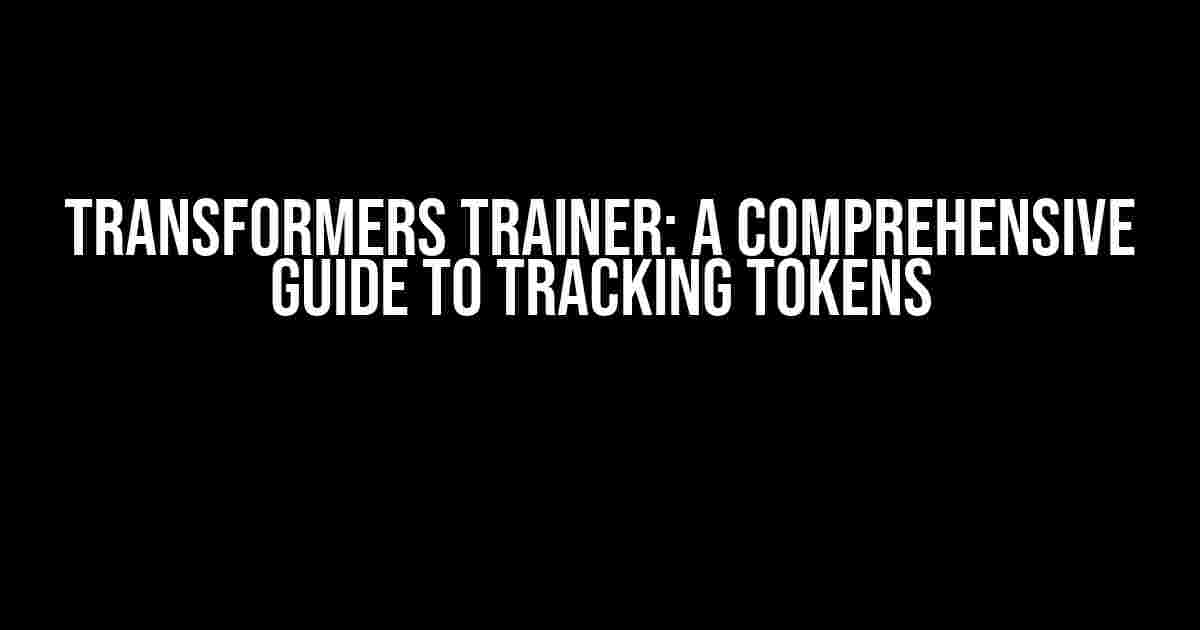Introduction
Are you an AI enthusiast trying to train a Transformers model, but keep encountering the error “Tried to track the number of tokens seen, however the current model is not configured properly to know what item is the input”? You’re not alone! This article will guide you through the process of configuring your Transformers model to track tokens, helping you overcome this frustrating error and achieve your AI goals.
The Problem: Understanding the Error
The error message “Tried to track the number of tokens seen, however the current model is not configured properly to know what item is the input” indicates that your Transformers model is unable to determine the input item. This occurs when the model is not properly configured to recognize the input data, leading to issues with token tracking.
Token Tracking: Why It Matters
Token tracking is a crucial aspect of Transformers training. It allows the model to understand the sequence of tokens (words or characters) in the input data, enabling it to process and analyze the data effectively. Without proper token tracking, your model may struggle to learn from the data, leading to subpar performance and inaccurate results.
Step-by-Step Solution
Follow these steps to configure your Transformers model to track tokens and resolve the error:
-
Check Your Model Configuration
Review your model’s configuration to ensure that it is properly set up to recognize the input data. Verify that the input data is correctly formatted and that the model is configured to accept the input data type.
from transformers import AutoModelForSequenceClassification, AutoTokenizer # Load pre-trained model and tokenizer model = AutoModelForSequenceClassification.from_pretrained("bert-base-uncased") tokenizer = AutoTokenizer.from_pretrained("bert-base-uncased") # Check model configuration print(model.config) -
Define the Input Data
Clearly define the input data and its format. This includes the data type, shape, and structure. Ensure that the input data is properly formatted and consistent throughout the training process.
# Define input data input_data = ["This is a sample sentence.", "Another sentence for training."] # Check input data format print(input_data[0]) -
Preprocess the Input Data
Preprocess the input data using the tokenizer to convert it into a format that the model can understand. This includes tokenization, padding, and truncation.
# Preprocess input data inputs = tokenizer(input_data, return_tensors="pt", max_length=512, padding="max_length", truncation=True) # Check preprocessed data print(inputs) -
Configure the Model for Token Tracking
Configure the model to track tokens by setting the `return_dict` parameter to `True`. This allows the model to return the tokenized input data, enabling token tracking.
# Configure model for token tracking model.config.return_dict = True # Check model configuration print(model.config) -
Train the Model
Train the model using the preprocessed input data. Monitor the model’s performance and adjust the hyperparameters as needed.
# Train the model model.train() optimizer = torch.optim.Adam(model.parameters(), lr=1e-5) for epoch in range(5): optimizer.zero_grad() outputs = model(**inputs) loss = outputs.loss loss.backward() optimizer.step() # Print model performance print(f"Epoch {epoch+1}, Loss: {loss.item():.4f}")
Troubleshooting Common Issues
If you encounter issues during the training process, refer to the following troubleshooting guide:
| Issue | Solution |
|---|---|
| Error: “Input data is not properly formatted.” | Verify that the input data is correctly formatted and consistent throughout the training process. Check the data type, shape, and structure. |
| Error: “Model is not configured to recognize input data.” | Review the model’s configuration and ensure that it is properly set up to recognize the input data type. Check the model’s `config` attribute. |
| Error: “Tokenization failed.” | Verify that the tokenizer is correctly configured and that the input data is properly formatted for tokenization. Check the tokenizer’s `config` attribute. |
Conclusion
By following the steps outlined in this article, you should be able to configure your Transformers model to track tokens and resolve the error “Tried to track the number of tokens seen, however the current model is not configured properly to know what item is the input”. Remember to carefully review your model’s configuration, preprocess the input data, and configure the model for token tracking. With these steps, you’ll be well on your way to training a successful Transformers model.
Additional Resources
For further assistance and guidance, refer to the following resources:
By mastering the art of token tracking, you’ll unlock the full potential of your Transformers model and achieve exceptional results in your AI projects.
Frequently Asked Question
Get answers to the most commonly asked questions about Transformers Trainer and token tracking issues.
What is the error message I’m seeing, and what does it mean?
The error message “Tried to track the number of tokens seen, however the current model is not configured properly to know what item is the input” indicates that the model is not set up to recognize the input item, which is necessary for token tracking. This means that the model is not receiving the input data correctly, and therefore, cannot track the number of tokens seen.
Why is the model not configured properly?
There could be several reasons why the model is not configured properly. One possible reason is that the input data is not correctly formatted or defined. Another reason could be that the model architecture is not compatible with the input data. It’s also possible that there’s a bug in the code that’s preventing the model from recognizing the input item.
How do I fix the model configuration issue?
To fix the issue, you’ll need to review your code and ensure that the input data is correctly defined and formatted. Check that the model architecture is compatible with the input data and that there are no bugs in the code. You may also need to review the documentation for the specific model and transformer library you’re using to ensure that you’re following the correct configuration procedures.
What are the consequences of not tracking tokens seen?
If the model is not able to track the number of tokens seen, it can lead to issues with model training and performance. The model may not be able to process the input data correctly, leading to poor results or errors. In severe cases, it can even cause the model to fail to train or make predictions.
Can I still use the model even if it’s not tracking tokens seen?
It’s not recommended to use a model that’s not tracking tokens seen. The model’s performance will likely be poor, and you may get inaccurate results. It’s better to troubleshoot and resolve the issue before using the model for training or making predictions.



